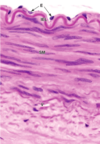Cardiovascular Flashcards
(53 cards)
Lymphatic vessels deliver lymph to what two veins?
internal jugular & subclavian
Systemic circulation sends blood from the __ side of the heart to the body
left
Layers of arteries & veins, outer to inner
Tunica adventitia (outer)
Tunica media
Tunica intima
Arteries & veins are made of similar components, but which has thicker walls? which has wider lumens?
Arteries have thicker walls
Veins have wider lumens
Which is the aorta and which is the vena cava? How can you tell?

The left one is the aorta, the right one is the vena cava.
The tunica media is much thicker in the aorta because it needs all those elastic fibers for its function; whereas, the tuncia adventitia is thicker in vena cava.
In arteries, the tunica intima is separated from the tunica media by ____. What is its purpose?
internal elastic lamina, full of elastin and fenestrae (gaps) that allow diffusion of substances to nourish cells deeps in teh vessel wall.

Tunica ___: one layer of endothelial cells supported by loose connective tissue and occasional smooth muscle cells.
Tunica ___: smooth muscle cells with variable amts of elastic fibers, reticular fibers (collagen type III), proteoglycans, and glycoproteins.
Tunica____: type I collagen & elastic fibers
Intima
Media
Adventitia
Elastic arteries
Composition, function, appearance, examples
- Composition: elastin
- Function: distention and recoil to stabilize blood flow
- Appearance:
- thicker intima than a muscular artery
- media has a lot of elastic fibers & elastic laminae (squiggles)
- Examples: aorta, carotids, subclavian arteries

Muscular arteries
Composition, function, appearance, examples
- Composition: much more smooth muscle
- Function: contracted state maintains blood pressure
- Appearance:
- prominent IEL
- A lot more smooth muscle cells in the media
- Examples: brachial, renal, ulnar, femoral arteries

What kind of artery is this?

Prominent IEL and no squiggles –> muscular arteries
Arteriosclerosis
Deposits of calcium and elastin cause hardening of muscular arteries, which produge collagen, elastin, and gorund substance components
The amount of ___ material increases with age in the tunica media of muscular arteries.
Elastic fibers increases, while smooth muscle decreases
Thus, the arteries stiffen.
The smallest arteries are what? Describe apperance and function.
Arterioles
- Tunica intima consists of endothelium
- Tunica media has only 1-2 layers of SM
- Tunica adventitia is a very small layer of connective tissue
- Function: controls blood flow into capillaries, operating as control valves via vasodilation & vasoconstriction

Terminal arterioles brancha nd give rise to networks of ___
capillaries.
Without the pressure control of arterioles & metaarterioles, capillaries would rupture.
Vasa vasorum
Blood vessels that supply the cells of the tunica adventitia and tunica media of large vessels
the ___ in the wall of the aorta, an elastic artery, is responsible for distention
collagen

Which works w a higher blood pressure - arteries or veins?
Arteries - thats why their walls are larger w/ elastin
systolic vs diastolic number
Systolic: blood pressure when heart pushes blood thru arteries
Diastolic: pressure in arteris when the heart rests between beats and fills with oxygenated blood
High bp (htn stage 1)
130/80
An arteriole ends in a ___, where the smooth muscle of the tunica media becomes a _____.
Metarteriole
Smooth muscle of tunica media becomes precapillary sphincter
Precapillary sphincters
Vasoconstrict or vasodilate to control a pulsatile blood flow into the cpaillary bed for..
- body temp control
- nutrient, waste, gas exchange
Capillaries join with ___ to start returning blood to teh heart
Poscapillary venules
Edema
Postcapillary venules (thin, permeable walls) allow inappropriate amts of lymph fluid to leak out and accumulate

Some lymphatic organs have venules lined with cuboidal endothelial cells that allow…
lymphocytes to extravasate between blood & tissue





















